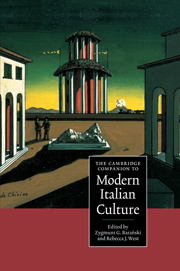Book contents
- Frontmatter
- Introducing modern Italian culture
- 1 The notion of Italy
- 2 Social and political cultures in Italy from 1860 to the present day
- 3 Questions of language
- 4 Intellectuals, culture and power in modern Italy
- 5 Catholicism
- 6 Socialism, Communism and other ‘isms’
- 7 Other voices: contesting the status quo
- 8 Narratives of self and society
- 9 Searching for new languages: modern Italian poetry
- 10 Drama: realism, identity and reality on stage
- 11 Italian cinema
- 12 Art in modern Italy: from the Macchiaioli to the Transavanguardia
- 13 A modern identity for a new nation: design in Italy since 1860
- 14 Fashion: narration and nation
- 15 The media
- 16 Since Verdi: Italian serious music 1860-1995
- 17 Folk music and popular song from the nineteenth century to the 1990s
- 18 Epilogue: Italian culture or multiculture in the new millennium?
- Index
- Series List
15 - The media
Published online by Cambridge University Press: 28 May 2006
- Frontmatter
- Introducing modern Italian culture
- 1 The notion of Italy
- 2 Social and political cultures in Italy from 1860 to the present day
- 3 Questions of language
- 4 Intellectuals, culture and power in modern Italy
- 5 Catholicism
- 6 Socialism, Communism and other ‘isms’
- 7 Other voices: contesting the status quo
- 8 Narratives of self and society
- 9 Searching for new languages: modern Italian poetry
- 10 Drama: realism, identity and reality on stage
- 11 Italian cinema
- 12 Art in modern Italy: from the Macchiaioli to the Transavanguardia
- 13 A modern identity for a new nation: design in Italy since 1860
- 14 Fashion: narration and nation
- 15 The media
- 16 Since Verdi: Italian serious music 1860-1995
- 17 Folk music and popular song from the nineteenth century to the 1990s
- 18 Epilogue: Italian culture or multiculture in the new millennium?
- Index
- Series List
Summary
Today, ownership and control of the media in Italy (the press and television broadcasting in particular) are so important as to determine the outcome of elections, and are a burning issue on the Italian political agenda. For this reason, rather than tell the story of the development of the media chronologically through the twentieth century, this chapter will start by outlining the institutional situation in the 1990s, which is illustrated with some facts and figures, and then proceed to discuss the chronological development of radio.
Who and what are the media for?
Firstly, it is generally agreed that the closer a state approaches to the ideal of democracy, the greater the need of the voters for information on which to base their choice of representatives. They need to know what exactly is happening in the country, what measures the elected representatives are enacting, and what policies candidates for election are proposing. Secondly, a nation coheres partly through values and beliefs concerning the history of its society, the meanings that have been given to life and to both personal and communal activity, as well as a common ‘language’ (verbal, visual, dress-codes, eating habits, etc.) shared or at least discussed by the community. Thirdly, people need to relax and laugh together; solitary people (like the elderly) need contact with others; and creative talent needs to find expression.
- Type
- Chapter
- Information
- The Cambridge Companion to Modern Italian Culture , pp. 293 - 310Publisher: Cambridge University PressPrint publication year: 2001
- 2
- Cited by



